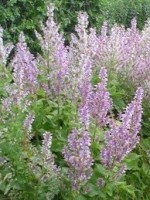 Clary is a biennial or short lived perennial native to southern Europe and the Mediterranean region but has been introduced to a variety of locations around the world and naturalized and become invasive in some including the US. It is a member of the mint family, Lamiaceae, that also includes rosemary, lavender and beebalm. In the first year plants form a basal rosette of broad, gray-green, downy leaves that are heart-shaped and 6-9” long. In the second year the rosette produces square multi branched hairy stems 3-5’ tall bearing terminal clusters of whorled two-lipped tubular flowers in summer. The flowers are white to lilac and subtended by purple to pale pink papery bracts. Both flowers and foliage are aromatic with a balsam like fragrance and the flowers are attractive to butterflies and bees. Clary has been used medicinally since ancient times and in making beer and wine. Plants are appropriate in herb, cottage, butterfly, and fragrance gardens. The genus name, Salvia, comes from the Latin word salveo meaning save or heal and refers to the curative properties of some members of the genus. The specific epithet, sclarea, comes from the Greek work skeria meaning hardness and refers to the hard parts of the flower petals. The common name clary comes from the Latin word clarus meaning clear, and refers to the use of the mucilaginous seed coat to clear the eyes of foreign material.Type: Biennial
Clary is a biennial or short lived perennial native to southern Europe and the Mediterranean region but has been introduced to a variety of locations around the world and naturalized and become invasive in some including the US. It is a member of the mint family, Lamiaceae, that also includes rosemary, lavender and beebalm. In the first year plants form a basal rosette of broad, gray-green, downy leaves that are heart-shaped and 6-9” long. In the second year the rosette produces square multi branched hairy stems 3-5’ tall bearing terminal clusters of whorled two-lipped tubular flowers in summer. The flowers are white to lilac and subtended by purple to pale pink papery bracts. Both flowers and foliage are aromatic with a balsam like fragrance and the flowers are attractive to butterflies and bees. Clary has been used medicinally since ancient times and in making beer and wine. Plants are appropriate in herb, cottage, butterfly, and fragrance gardens. The genus name, Salvia, comes from the Latin word salveo meaning save or heal and refers to the curative properties of some members of the genus. The specific epithet, sclarea, comes from the Greek work skeria meaning hardness and refers to the hard parts of the flower petals. The common name clary comes from the Latin word clarus meaning clear, and refers to the use of the mucilaginous seed coat to clear the eyes of foreign material.Type: Biennial
Bloom: Terminal clusters of whorled two-lipped tubular flowers that are white to lilac and subtended by purple to pale pink papery bracts, in summer
Size: 3-5′ H x 2-3′ W
Light: Full sun
Soil: Average, medium moist to dry, well-drained
Hardiness: Zones 5-9
Care: Low maintenance
Pests and Diseases: Slugs, snails, leafhoppers
Propagation: Seed, division in fall or spring; self seeds
Companion Plants: Other herbs such as rosemary and thyme, Achillea ‘Moonshine’, oriental poppy